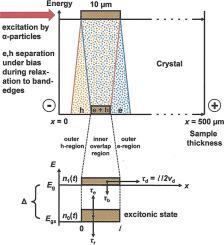当前位置:
X-MOL 学术
›
Diam. Relat. Mater.
›
论文详情
Our official English website, www.x-mol.net, welcomes your
feedback! (Note: you will need to create a separate account there.)
Modeling novel effects in transient current measurements of single-crystal CVD diamond with carrier excitation by MeVα-particles
Diamond and Related Materials ( IF 4.3 ) Pub Date : 2021-01-01 , DOI: 10.1016/j.diamond.2020.108166 Rolf Sauer
Diamond and Related Materials ( IF 4.3 ) Pub Date : 2021-01-01 , DOI: 10.1016/j.diamond.2020.108166 Rolf Sauer

|
Abstract Temperature- and electric field-dependent transient current measurements with 4.6 MeV high-energy α-particle excitation were reported recently in commercially available CVD diamonds and were used to extract drift velocities and drift mobilities of electrons and holes (Jansen et al., 2012, 2013 [1–3]). These data showed unexpected characteristic temperature-dependent pulse current profiles which remained unexplained as well as other novel observations. Here we interpret all experimental findings by a detailed physical model. It demonstrates that the measured electron or hole currents consist of two components one of which is constant in intensity whereas the other is temperature-dependent due to thermal activation of carriers out of a low-temperature storage state shown to consist of electron-hole droplets (EHDs); this is a condensed phase of electrons and holes. EHDs form in regions with electrons and holes embedded between adjacent regions with electrons or holes alone. This local separation is caused by the electric field during carrier relaxation from the highly excited states. The model describes all experimental findings very satisfactorily, some of them quantitatively. Maxima in the transit time as a function of temperature were experimentally reported (Jansen et al., 2013 [2, 3]) which successively become more pronounced at decreasing electric fields while shifting to lower temperatures. This observation is modeled by temperature-controlled re-population of the “slow” and “fast” conduction band valleys split apart by the applied electric field upon lifting the sixfold valley orientational degeneracy. The model suggests that the novel effects are characteristic of the very high excitation energy of the free excess carriers and would not be observable for near-band gap excitation.
中文翻译:

用 MeVα 粒子激发载流子激发单晶 CVD 金刚石瞬态电流测量的新效应建模
摘要 最近在商用 CVD 金刚石中报道了使用 4.6 MeV 高能 α 粒子激发进行的温度和电场相关瞬态电流测量,并用于提取电子和空穴的漂移速度和漂移迁移率(Jansen 等人,2012 年) , 2013 [1–3])。这些数据显示了出乎意料的特征温度相关脉冲电流曲线,这些曲线仍然无法解释以及其他新观察。在这里,我们通过详细的物理模型解释所有实验结果。它表明所测得的电子或空穴电流由两个分量组成,其中一个分量的强度是恒定的,而另一个分量是温度依赖性的,这是由于载流子脱离低温存储状态的热活化,显示为由电子-空穴液滴组成( EHD);这是电子和空穴的凝聚相。EHD 形成在电子和空穴嵌入相邻区域之间的区域中,仅具有电子或空穴。这种局部分离是由载流子从高激发态弛豫期间的电场引起的。该模型非常令人满意地描述了所有实验结果,其中一些是定量的。实验报告了作为温度函数的传输时间最大值(Jansen 等人,2013 [2, 3]),随着电场的降低,同时转向较低的温度,这些最大值逐渐变得更加明显。这种观察是通过“慢”和“快”导带谷在解除六重谷取向简并时被施加的电场分开的温度控制的重新填充来建模的。
更新日期:2021-01-01
中文翻译:

用 MeVα 粒子激发载流子激发单晶 CVD 金刚石瞬态电流测量的新效应建模
摘要 最近在商用 CVD 金刚石中报道了使用 4.6 MeV 高能 α 粒子激发进行的温度和电场相关瞬态电流测量,并用于提取电子和空穴的漂移速度和漂移迁移率(Jansen 等人,2012 年) , 2013 [1–3])。这些数据显示了出乎意料的特征温度相关脉冲电流曲线,这些曲线仍然无法解释以及其他新观察。在这里,我们通过详细的物理模型解释所有实验结果。它表明所测得的电子或空穴电流由两个分量组成,其中一个分量的强度是恒定的,而另一个分量是温度依赖性的,这是由于载流子脱离低温存储状态的热活化,显示为由电子-空穴液滴组成( EHD);这是电子和空穴的凝聚相。EHD 形成在电子和空穴嵌入相邻区域之间的区域中,仅具有电子或空穴。这种局部分离是由载流子从高激发态弛豫期间的电场引起的。该模型非常令人满意地描述了所有实验结果,其中一些是定量的。实验报告了作为温度函数的传输时间最大值(Jansen 等人,2013 [2, 3]),随着电场的降低,同时转向较低的温度,这些最大值逐渐变得更加明显。这种观察是通过“慢”和“快”导带谷在解除六重谷取向简并时被施加的电场分开的温度控制的重新填充来建模的。









































 京公网安备 11010802027423号
京公网安备 11010802027423号